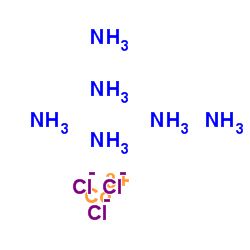HEXAAMMINECOBALT(III) CHLORIDE

HEXAAMMINECOBALT(III) CHLORIDE structure
|
Common Name | HEXAAMMINECOBALT(III) CHLORIDE | ||
|---|---|---|---|---|
| CAS Number | 10534-89-1 | Molecular Weight | 267.475 | |
| Density | 1.71 g/mL at 25 °C(lit.) | Boiling Point | N/A | |
| Molecular Formula | H18Cl3CoN6 | Melting Point | 217 °C(lit.) | |
| MSDS | Chinese USA | Flash Point | N/A | |
| Symbol |

GHS08 |
Signal Word | Danger | |
|
HCC ligation: rapid and specific DNA construction with blunt ended DNA fragments.
Nucleic Acids Res. 14(24) , 10118, (1986)
|
|
|
Iron regulatory element and internal loop/bulge structure for ferritin mRNA studied by cobalt(III) hexammine binding, molecular modeling, and NMR spectroscopy.
Biochemistry 37(6) , 1505-12, (1998) The ferritin IRE, a highly conserved (96-99% in vertebrates) mRNA translation regulatory element in animal mRNA, was studied by molecular modeling (using MC-SYM and DOCKING) and by NMR spectroscopy. Cobalt(III) hexammine was used to model hydrated Mg2+. IRE i... |
|
|
Protection of megabase DNA from shearing.
Nucleic Acids Res. 23(19) , 3999-4000, (1995)
|
|
|
The electron-transfer site of spinach plastocyanin.
Biochemistry 27(16) , 5876-84, (1988) Two sites for electron transfer have been proposed for plastocyanin: one near the copper ion and the other close to the acid patch formed by residues 42-45. Calculations of electrostatic properties of spinach plastocyanin and ionic strength dependences of ele... |
|
|
Reversible hypercondensation and decondensation of mitotic chromosomes studied using combined chemical-micromechanical techniques.
J. Cell. Biochem. 85(2) , 422-34, (2002) We show that the chromatin in mitotic chromosomes can be drastically overcompacted or unfolded by temporary shifts in ion concentrations. By locally 'microspraying' reactants from micron-size pipettes, while simultaneously monitoring the size of and tension i... |
|
|
Methylation and restriction endonuclease cleavage of linear Z-DNA in the presence of hexamminecobalt (III) ions.
Nucleic Acids Res. 14(18) , 7237-52, (1986) These studies employed the synthetic linear DNA, poly dGdC, in the B and cobalt hexammine chloride (Co)-induced Z form to determine the effect of conformation on protein-DNA interactions. The rate of the reaction of the restriction endonucleases, Hha I and Cf... |
|
|
Metal ion-binding studies highlight important differences between flaviviral RNA polymerases.
Biochim. Biophys. Acta 1794(1) , 50-60, (2009) West Nile virus (WNV) is a member of the Flaviviridae family which includes a number of important human pathogens. The WNV NS5 protein harbors an RNA-dependent RNA polymerase activity which is required both for replication and transcription of the viral genom... |
|
|
Solution probing of metal ion binding by helix 27 from Escherichia coli 16S rRNA.
RNA 11(11) , 1688-700, (2005) Helix (H)27 from Escherichia coli 16S ribosomal (r)RNA is centrally located within the small (30S) ribosomal subunit, immediately adjacent to the decoding center. Bacterial 30S subunit crystal structures depicting Mg(2+) binding sites resolve two magnesium io... |
|
|
Photocleavage of avidin by a new pyrenyl probe.
J. Photochem. Photobiol. B, Biol. 103(3) , 251-5, (2011) In this study, a new small-molecule-based reagent was designed to recognize and bind to specific site in protein. A new pyrenyl probe, d-biotinyl-1(1-pyrene)methylamide (Py-biotin) was designed and synthesized by coupling of d-biotin to 1(1-pyrene)methylamine... |
|
|
Role of the environment in the interaction of nonintercalators with Z-DNA.
J. Biomol. Struct. Dyn. 7(2) , 335-45, (1989) Interaction of the DNA binding nonintercalators Netropsin, Distamycin and the mPD derivative with Z-DNA has been studied. It has been found that environmental factors like the solvent and added cations significantly modulate the interaction of these ligands w... |